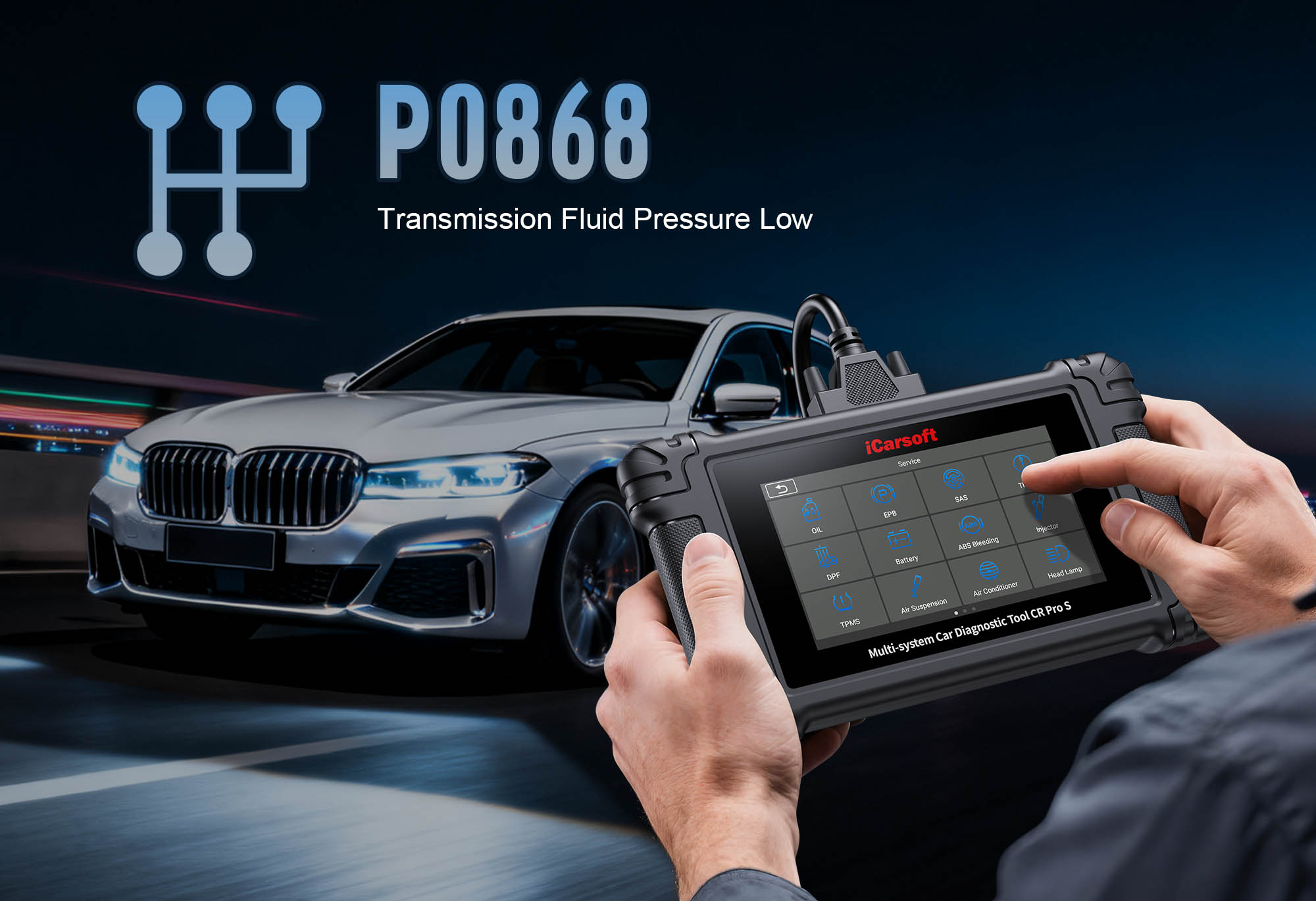P0868 Code: Diagnose & Clear Transmission Fluid Pressure Low – Circuit High with iCarsoft CR Pro S
If your check engine light flashes on and you notice symptoms like delayed gear engagement, weak acceleration, or transmission slipping—especially when the engine is warm—a diagnostic scan will likely return P0868. This OBD-II code stands for "Transmission Fluid Pressure Low – Circuit High," indicating the Transmission Control Module (TCM) has detected two critical issues: insufficient hydraulic pressure in the transmission system and an abnormal high-voltage signal in the pressure-sensing circuit.
Transmission fluid pressure is the lifeblood of automatic transmissions: it powers gear shifts, engages clutches, and cools moving parts. The TCM relies on pressure sensors and solenoids to monitor and adjust this pressure—if pressure drops too low (e.g., from leaks or a failing pump) and the circuit sending pressure data to the TCM malfunctions (e.g., shorted wiring), P0868 triggers. Left unaddressed, this combination can lead to catastrophic transmission failure—clutches burn out, gears seize, and repairs can cost $2,000+.
Basic scanners may only flag "low fluid pressure" but can’t distinguish between mechanical pressure issues and electrical circuit faults. The iCarsoft CR Pro S, with its dual-focused diagnostics (pressure monitoring + circuit testing), global transmission coverage, and bi-directional controls, solves this. Let’s walk through how to diagnose and resolve P0868 safely.
Understanding P0868: Causes & Key Symptoms
P0868’s "low pressure + high circuit voltage" dual fault creates distinct symptoms that worsen as pressure drops or the circuit degrades—these clues help separate mechanical (pressure) from electrical (circuit) issues.
Key Symptoms of P0868
-
Delayed Gear Engagement: It takes 3–5 seconds (instead of 1–2) for the transmission to shift into Drive/Reverse—caused by low pressure struggling to engage clutches.
-
Weak Acceleration: The engine revs high, but vehicle speed increases slowly (slipping clutches due to insufficient pressure).
-
Harsh or Erratic Shifts: Pressure spikes (from circuit malfunctions) cause "slamming" gears, while low pressure leads to soft, delayed shifts.
-
Transmission Overheating: Low pressure reduces fluid flow, limiting cooling—look for a "Transmission Hot" warning or burnt-smelling fluid.
-
Limp Mode Activation: The TCM locks the transmission in 2nd/3rd gear to prevent damage, limiting speed to 30–40 mph.
-
Intermittent Symptoms: High circuit voltage may cause issues only when warm (wire expansion) or vibrating (loose connectors).
Common Causes of P0868
|
Cause
|
Description
|
|
Low Transmission Fluid
|
Leaks (hoses, pans, seals) or neglected fluid changes leave the system without enough pressure to operate.
|
|
Failed Transmission Pump
|
The pump that circulates fluid wears out (common in vehicles >150,000 miles), reducing hydraulic pressure.
|
|
Clogged Transmission Filter
|
Debris blocks fluid flow, lowering pressure and forcing the TCM to send high-voltage signals to compensate.
|
|
Wiring/Circuit Short
|
A frayed wire in the pressure sensor circuit touches the engine’s positive terminal, creating a high-voltage short.
|
|
Faulty Pressure Sensor
|
The sensor sends false high-voltage signals to the TCM, even if pressure is normal—triggers P0868.
|
|
Damaged Valve Body
|
A stuck valve blocks fluid passages, lowering pressure and disrupting the TCM’s circuit readings.
|
|
TCM Malfunction
|
Outdated firmware or internal faults cause the TCM to misinterpret pressure data, leading to false high-voltage alerts.
|
Why iCarsoft CR Pro S Excels at Diagnosing P0868
The CR Pro S outperforms basic tools with features tailored to P0868’s dual (mechanical + electrical) fault nature—critical for avoiding misdiagnosis:
Dual Diagnostics (Pressure + Circuit)
Monitors real-time fluid pressure and circuit voltage simultaneously—distinguishes low pressure from high-voltage shorts.
Bi-Directional Pump/Solenoid Tests
Manually activates the transmission pump and solenoids to verify if they generate adequate pressure—rules out mechanical faults.
Global Vehicle/Transmission Coverage
Works with 500+ models (Mercedes-Benz, BMW, Ford, Toyota) and transmission types (6-speed, 8-speed, CVT) for pressure system variations.
Circuit Short Detection
Identifies shorted wires or faulty sensors with precision—avoids replacing pumps/filters when the issue is electrical.
Lifetime Free TCM Updates
Wi-Fi updates fix P0868 false triggers from outdated TCM software (common in 2018+ vehicles).
3D Component Mapping
Displays diagrams of pressure sensors, pumps, wiring, and valve bodies—avoids misdisassembly and speeds inspections.
Step-by-Step: Diagnose P0868 with iCarsoft CR Pro S
-
Check Transmission Fluid Level & Leaks First
1. Park on level ground, start the engine, and let it reach operating temperature (5–10 minutes).
2. Locate the transmission dipstick (use CR Pro S’s Component Location tool) or fill port (sealed transmissions).
3. Dipstick Models: Ensure fluid is between "MIN" and "MAX." Add manufacturer-recommended fluid if low (check Fluid Guide).
4. Sealed Models: Use Transmission Fluid Temperature (TFT) Readout (175–200°F) to check level via fill port—avoid overfilling.
5. Leak Inspection: Look for wet spots under the transmission pan, hoses, or seals (small leaks lower pressure over time).
-
Connect the CR Pro S & Confirm the Code
1. Plug the CR Pro S into the OBD-II port (use OBDI adaptors for older models: Mercedes 38Pin, BMW 20Pin).
2. Select your vehicle via Auto VIN Identify (instant specs) or manual entry.
3. Navigate to Transmission > Fault Codes > Read Codes to confirm P0868. Tap Code Details for vehicle-specific tips (e.g., "Toyota Camry: Check Pump & Pressure Sensor Near Valve Body").
-
Locate Key Components (Pressure Sensor, Pump, Circuit)
1. Go to Component Location > Transmission > Pressure System.
2. Use the diagram to identify:
- Pressure Sensor: On transmission case (near valve body) with 3–4 pin connector.
- Transmission Pump: Front of transmission (connected to torque converter)—generates pressure.
- Wiring Harness: Path to TCM (check for damage near exhaust/moving parts).
- Filter/Valve Body: Filter inside pan; valve body beneath pan (controls fluid flow).
-
Analyze Live Pressure & Circuit Data
1. Start the engine, shift to Drive (parking brake engaged), and idle for 5 minutes.
2. Navigate to Transmission > Live Data > Pressure & Circuit and monitor:
- Fluid Pressure: Normal = 40–100 psi. P0868 = <30 psi (low) + circuit voltage >5V (high).
- Pressure Sensor Voltage: Normal = 0.5–4.5V. >5V = shorted sensor/wiring.
- TCM Command vs. Actual Pressure: TCM "commands high pressure" but actual stays low = pump/filter fault.
- Battery Voltage: Use Battery Voltage Test to rule out <12V (disrupts sensor signals).
-
Test the Pressure Circuit for Shorts/Faults
1. Circuit Short Detection: - Turn off engine, disconnect pressure sensor connector.
- Use Multimeter Function:
- Signal pin → ground: Normal = infinite resistance. Continuity = shorted wire.
- Power pin → ground: Normal = 12V. >12V = faulty voltage regulator.
2. Sensor Resistance Test: - Remove sensor. Measure resistance (specs: 1,000–3,000 ohms). <100 ohms = shorted (replace).
3. Wiring Inspection: - Follow CR Pro S’s wiring map—look for frayed insulation touching 12V components (e.g., alternator).
-
Test Transmission Pump & Pressure Generation
1. Bi-Directional Pump Activation: - Engine off. Go to Special Functions > Transmission > Actuation Tests > Pump Control.
- Run "Manual Pump Activation" for 30 seconds (supported transmissions).
- Connect mechanical pressure gauge to test port (guided by CR Pro S):
- >30 psi = Pump works (issue = clogged filter/valve body).
- <30 psi = Pump faulty (professional replacement needed).
2. Filter Inspection: - Remove transmission pan (use Torque Guide). Replace clogged filter and clean pan.
-
Inspect Valve Body & Clear Clogs
1. Valve Body Access: - After pan removal, locate valve body (CR Pro S diagram). Remove per torque specs (avoid warping).
2. Cleaning/Inspection: - Flush passages with transmission cleaner. Tap stuck valves gently to free. Replace worn seals/gaskets (use Part Lookup).
-
Rule Out TCM Issues
1. TCM Firmware Update: - Go to System > Update Manager to install free updates (fixes misinterpreted pressure data).
2. TCM Signal Validation: - Send simulated pressure data to TCM. Recognition = Software issue resolved; no recognition = TCM repair needed.
-
Repair & Clear P0868
1. Fix the root cause:
- Electrical: Replace shorted sensor, splice wires, or repair grounded circuit.
- Mechanical: Fix leaks, replace filter, or have pump repaired.
- Software: Update TCM firmware via CR Pro S.
2. Clear the code: Navigate to Transmission > Fault Codes > Clear Codes to delete P0868.
-
Validate the Repair
1. Recheck live data: Pressure = 40–100 psi; sensor voltage = 0.5–4.5V.
2. Test drive 40–50 minutes: No slipping, delays, or warning lights.
3. Post-drive scan: Use Transmission System Scan after 100 miles to confirm P0868 doesn’t return.
Preventing P0868 Recurrence
Use the iCarsoft CR Pro S to maintain transmission pressure and circuit health long-term:
-
Fluid Maintenance: Set Service Reminder to replace transmission fluid every 60,000 miles (40,000 miles for towing).
-
Leak Checks: Use Fluid Level Log to track levels monthly—catch small leaks before pressure drops.
-
Circuit Inspections: Include pressure sensor wiring in annual electrical scans—clean connectors to prevent corrosion.
-
Pump Health Monitoring: Use Pump Pressure History to flag declining pressure (early sign of pump wear).
Conclusion
P0868’s "low pressure + high circuit voltage" fault is a warning sign of impending transmission failure—but the iCarsoft CR Pro S turns panic into precision. With dual diagnostics for pressure and circuits, bi-directional tests, and global coverage, it ensures you fix the root cause (not just the symptom).
By using the CR Pro S to resolve P0868, you’ll restore transmission pressure, protect clutches and gears, and avoid costly rebuilds—keeping your vehicle on the road for years.
FAQs About P0868 Code
Q: Can I drive with P0868?
A: No—driving with P0868 risks catastrophic transmission failure. Even short trips can burn clutches or seize gears. Address it immediately.
Q: How much does it cost to fix P0868?
A: $100–$300 for fluid/filter service or sensor replacement; $500–$1,500 for transmission pump repair; $2,000+ for full transmission rebuild (if neglected). The CR Pro S ($300–$400) saves by targeting the root cause early.
Q: Will adding transmission fluid fix P0868?
A: Only if low fluid is the sole cause. Use the CR Pro S to check circuit voltage—if it’s still high (>5V), adding fluid won’t resolve the electrical fault.
Q: Is P0868 the same as P0869?
A: No—P0868 = "Low Pressure – Circuit High," while P0869 = "Low Pressure – Circuit Low." The CR Pro S distinguishes them via circuit voltage readings (high vs. low).





